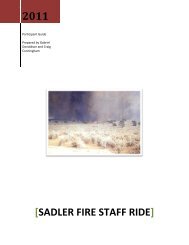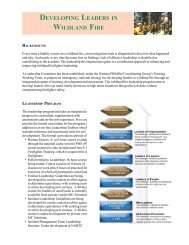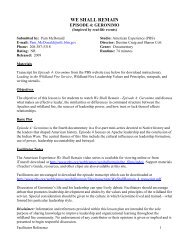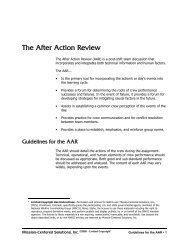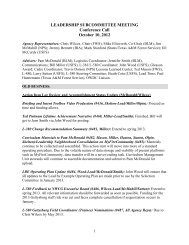example tdgs/stex #2 - Wildland Fire Leadership Development
example tdgs/stex #2 - Wildland Fire Leadership Development
example tdgs/stex #2 - Wildland Fire Leadership Development
Create successful ePaper yourself
Turn your PDF publications into a flip-book with our unique Google optimized e-Paper software.
How TDGS Work<br />
PART I<br />
Designing Tactical Decision Games<br />
1. TDGS are Simple…Keep them Simple.<br />
• Role-Playing: The players are put in the role of a leader of a given unit, in a given<br />
situation, with given resources, and a given scenario.<br />
• Limited Information: The players will not have as much information about the<br />
scenario as they might like. This is an important feature of TDGS; uncertainty,<br />
confusion, and complications are basic characteristics of tactical decision-making.<br />
• Limited Time: The players will have limited time to make a decision, since this is<br />
also a feature of making tactical decisions.<br />
• Face a Dilemma: The scenario puts the players in a situation requiring some sort<br />
of decision; a problem requiring a solution. Despite the above limitations, the<br />
players must come up with a workable solution.<br />
• After Action Review (AAR): The players analyze or discuss their solution as a<br />
means of drawing out the lesson of the experience.<br />
2. The Primary Objectives of TDGS<br />
• Exercise Decision-Making Skills in a Tactical Context: This is the fundamental<br />
objective!<br />
• Practice Communicating Decisions: Players must communicate decisions by<br />
giving clear text instructions while using all the appropriate elements listed in the<br />
standard briefing checklist outlined in the Incident Response Pocket Guide (IRPG).<br />
It is recommended that the players adhere to the appropriate elements of the<br />
briefing checklist found in the IRPG.<br />
• Provide Vicarious Experience to Develop Pattern Recognition Skills:<br />
Experience is the only way to develop the pattern recognition skills that are<br />
essential for effective decision-making. Since actual fire experience may be<br />
limited and involves certain risk, TDGS provide a safe alternative.<br />
3. Additional Benefits<br />
In addition to the primary objectives, TDGS offer several secondary benefits:<br />
• Illustrate Tactical Concepts: Effective use of fire suppression methods and<br />
techniques, resource capabilities, resource deployment, etc. can be explained as<br />
part of the post scenario discussion.<br />
6



